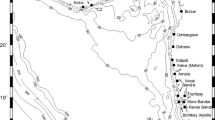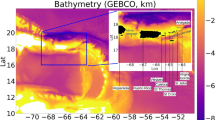Abstract
An accurate prediction of ocean tides in southeast Alaska is developed using a regional, barotropic ocean model with a finite difference scheme. The model skill is verified by the observational tidal harmonics in southeast Alaska including Glacier Bay. The result is particularly improved in Glacier Bay compared to the previous model described by Foreman et al. (2000). The model bathymetry dominates the model skill. We re-estimate tidal energy dissipation in the Alaska Panhandle and suggest a value for tidal energy dissipation of 3.4 GW associated with the M2 constituent which is 1.5 times the estimation of Foreman et al. (2000). A large portion of the M2 energy budget entering through Chatham Strait is dissipated in the vicinity of Glacier Bay. Moreover, it is shown that the developed model has the potential to correct the ocean tide loading effect in geodetic data more efficiently than the model of Foreman et al. (2000), especially around Glacier Bay.
Similar content being viewed by others
References
Akaike, H. (1980): Likelihood and Bayes procedure. p. 1–13. In Bayesian Statistics, ed. by J. M. Bernardo, M. H. De Groot, D. V. Lindley and A. F. M. Smith, University Press, Valencia.
Allinson, C. R., P. J. Clarke, S. J. Edwards, M. A. King, T. F. Baker and P. R. Cruddace (2004): Stability of direct GPS estimates of ocean tide loading. Geophys. Res. Lett., 31, L15603, doi: 10.1029/2004GL020588.
Arakawa, A. and V. R. Lamb (1981): A potential enstrophy and energy conserving scheme for the shallow water equations. Mon. Wea. Rev., 109, 18–36.
Asselin, R. (1972): Frequency filter for time integrations. Mon. Wea. Rev., 100, 487–490.
Carlson, P. R., P. Hooge, G. Cochrane, A. Stevenson, P. Dartnell and K. Lee (2002): Multibeam bathymetry and selected perspective views of main part of Glacier Bay, Alaska. U.S. Geological Survey Open-File Report 02-391. Available at https://doi.org/geopubs.wr.usgs.gov/open-file/of02-391
Chen, C., H. Liu and R. C. Beardsley (2003): An unstructured grid, finite-volume, three-dimensional, primitive equations ocean model: Application to coastal ocean and estuaries. J. Atmos. Oceanic Technol., 20, 159–186.
Choi, K., A. Bilich, K. M. Larson and P. Axelrad (2004): Modified sidereal filtering: Implications for high-rate GPS positioning. Geophys. Res. Lett., 31, L22608, doi:10.1029/2004GL021621.
Cokelet, E. D., A. D. Jenkins and L. L. Etherington (2004): A transect of Glacier Bay ocean currents measured by acoustic Doppler current profiler (ADCP). Proc. 4th Glacier Bay Science Symp., 80–83.
Colbo, K. (2006): Lateral Reynolds stress and eddy viscosity in a coastal strait. J. Phys. Oceanogr., 36, 770–783.
Cushman-Roisin, B., A. J. Willmott and N. R. T. Biggs (2005): Influence of stratification on decaying surface seiche modes. Cont. Shelf Res., 25, 227–242.
Dehant, V., P. Defraigne and J. M. Wahr (1999): Tides for a convective Earth. J. Geophys. Res., 104, 1035–1058.
Dziewonski, A. M. and D. L. Anderson (1981): Preliminary reference Earth model. Phys. Earth Planet. Inter., 25, 297–356.
Edwards, K. A., P. MacCready, J. N. Moum, G. Pawlakd, J. M. Klymake and A. Perline (2004): Form drag and mixing due to tidal flow past a sharp point. J. Phys. Oceanogr., 34, 1297–1312.
Egbert, G. D. and R. D. Ray (2003): Semi-diurnal and diurnal tidal dissipation from TOPEX/Poseidon altimetry. Geophys. Res. Lett., 30, 1907, doi:10.1029/2003GL017676.
Farrell, W. E. (1972): Deformation of the Earth by surface loads. Rev. Geophys. Space Phys., 10, 761–797.
Foreman, M. G. G., R. F. Henry, R. A. Walters and V. A. Ballantyne (1993): A finite element model for tides and resonance along the north coast of British Columbia. J. Geophys. Res., 98, 2509–2531.
Foreman, M. G. G., W. R. Crawford, J. Y. Cherniawsky, R. F. Henry and M. R. Tarbotton (2000): A high-resolution assimilating tidal model for the northeast Pacific Ocean. J. Geophys. Res., 105, 28629–28651.
Gargett, A. E. (1976): Generation of internal waves in the Strait of Georgia, British Columbia. Deep-Sea Res., 23, 17–32.
Hatanaka, Y., A. Sengoku, T. Sato, J. M. Johnson, C. Rocken and C. Meertens (2001): Detection of tidal loading signals from GPS permanent array of GSI Japan. J. Geod. Soc. Japan, 47, 187–192.
Hirose, N. and J.-H. Yoon (1996): Barotropic response to the wind in the Japan Sea. Proc. 4th CREAMS Workshop, 39–43.
Ishiguro, M., H. Akaike, M. Ooe and S. Nakai (1983): A Bayesian approach to the analysis of Earth tides. p. 283–292. In Proc. 9th Int. Symp. Earth Tides, ed. by J. T. Kuo, E. Schweizerbart’sche Verlangsbuchhandlung, Stuttgart.
Japan Hydrographic Association (1999): Research on bottom topography using satellite altimeter data. Japan Hydrographic Association Survey Research Report, 96, 89 pp. (in Japanese).
Kantha, L. H. and C. A. Clayson (2000): Numerical Models of Oceans and Oceanic Processes. Academic Press, San Diego, 940 pp.
Kim, C.-H. and J.-H. Yoon (1996): Modeling of the wind-driven circulation in the Japan Sea using a reduced gravity model. J. Oceanogr., 52, 359–373.
Kowalik, Z. and A. Y. Proshutinsky (1993): Diurnal tides in the Arctic Ocean. J. Geophys. Res., 98, 16449–16468.
Larsen, C. F., K. A. Echelmeyer, J. T. Freymueller and R. J. Motyka (2003): Tide gauge records of uplift along the northern Pacific-North American plate boundary, 1937 to 2001. J. Geophys. Res., 108, 2216, doi:10.1029/2001JB001685.
Larsen, C. F., R. J. Motyka, J. T. Freymueller, K. A. Echelmeyer and E. R. Ivins (2004): Rapid uplift of southern Alaska caused by recent ice loss. Geophys. J. Int., 158, 1118–1133.
Le Provost, C. and F. Lyard (1997): Energetics of the M2 barotropic ocean tides: An estimate of bottom friction dissipation from a hydrodynamic model. Prog. Oceanogr., 40, 37–52.
Lefèvre, F., C. Le Provost and F. H. Lyard (2000): How can we improve a global ocean tide model at a regional scale? A test on the Yellow Sea and the East China Sea. J. Geophys. Res., 105, 8707–8726.
Levitus, S. and T. P. Boyer (1994): World Ocean Atlas 1994, vol. 4, Temperature. NOAA Atlas NESDIS, vol. 4, NOAA, Silver Spring, Md.
Levitus, S., R. Burgett and T. P. Boyer (1994): World Ocean Atlas 1994, vol. 3, Salinity. NOAA Atlas NESDIS, vol. 3, NOAA, Silver Spring, Md.
Lindquist, K. G., K. Engle, D. Stahlke and E. Price (2004): Global topography and bathymetry grid improves research efforts. EOS, Trans. Am. Geophys. Union, 85, 186.
Lyard, F. (1997): The tides in the Arctic Ocean from a finite element model. J. Geophys. Res., 102, 15611–15638.
Lyard, F. and C. Le Provost (1997): Energy budget of the tidal hydrodynamic model FES94.1. Geophys. Res. Lett., 24, 687–690.
Lyard, F., F. Lefèvre, T. Letellier and O. Francis (2006): Modelling the global ocean tides: Modern insights from FES2004. Ocean Dyn., 56, 394–415.
Marks, K. M. and W. H. F. Smith (2006): An evaluation of publicly available global bathymetry grids. Mar. Geophys. Res., 27, 19–34.
Meier, M. F. and A. Post (1987): Fast tidewater glaciers. J. Geophys. Res., 92, 9051–9058.
Miller, G. R. (1966): The flux of tidal energy out of the deep oceans. J. Geophys. Res., 71, 2485–2489.
Ono, J., K. I. Ohshima, G. Mizuta, Y. Fukamachi and M. Wakatsuchi (2008): Diurnal coastal-trapped waves on the eastern shelf of Sakhalin in the Sea of Okhotsk and their modification by sea ice. Cont. Shelf Res., 28, 697–709.
Pawlowicz, R. (2002): Observations and linear analysis of sillgenerated internal tides and estuarine flow in Haro Strait. J. Geophys. Res., 107, 3056, doi:10.1029/2000JC000504.
Prinsenberg, S. J. (1988): Damping and phase advance of the tide in western Hudson Bay by the annual ice cover. J. Phys. Oceanogr., 18, 1744–1751.
Rodríguez, G. and M. J. Sevilla (2002): Correlation between sea surface topography and bathymetry in shallow shelf waters in the Western Mediterranean. Geophys. J. Int., 150, 573–587.
Sandwell, D. T. and W. H. F. Smith (2001): Chapter 12, Bathymetric estimation. p. 441–457. In Satellite Altimetry and Earth Sciences, ed. by L.-L. Fu and A. Cazenave, Academic Press, San Diego.
Sato, T. and H. Hanada (1984): A program for the computation of oceanic tidal loading effects ‘GOTIC’. Publ. Int. Lat. Obs. Mizusawa, 18, 29–47.
Sato, T., S. Miura, Y. Ohta, H. Fujimoto, W. Sun, C. F. Larsen, M. Heavner, M. Kaufmanand J. T. Freymueller (2008): Earth tides observed by gravity and GPS in southeastern Alaska. J. Geodyn., 46, 78–89.
Smith, W. H. F. and D. T. Sandwell (1997): Global sea floor topography from satellite altimetry and ship depth soundings. Science, 277, 1956–1962.
St. Laurent, L. C. and C. Garrett (2002): The role of internal tides in mixing the deep ocean. J. Phys. Oceanogr., 32, 2882–2899.
St. Laurent, L. C., H. L. Simmons and S. R. Jayne (2002): Estimating tidally driven mixing in the deep ocean. Geophys. Res. Lett., 29, 2106, doi:10.1029/2002GL015633.
Stigebrandt, A. (1999): Resistance to barotropic tidal flow in straits by baroclinic wave drag. J. Phys. Oceanogr., 29, 191–197.
Takasu, T. (2006): High-rate Precise Point Positioning: detection of crustal deformation by using 1-Hz GPS data. GPS/GNSS Symp. 2006, Tokyo, 52–59.
Takasu, T. and S. Kasai (2005): Development of precise orbit/clock determination software for GPS/GNSS. Proc. 49th Space Sciences and Technology Conference, 1223–1227.
Tamura, Y., T. Sato, M. Ooe and M. Ishiguro (1991): A procedure for tidal analysis with a Bayesian information criterion. Geophys. J. Int., 104, 507–516.
Tanaka, Y., T. Hibiya and Y. Niwa (2007): Estimates of tidal energy dissipation and diapycnal diffusivity in the Kuril Straits using TOPEX/POSEIDON altimeter data. J. Geophys. Res., 112, C10021, doi: 10.1029/2007JC004172.
Zumberge, J. F., M. B. Heflin, D. C. Jefferson, M. M. Watkins and F. H. Webb (1997): Precise point positioning for the efficient and robust analysis of GPS data from large networks. J. Geophys. Res., 102, 5005–5017.
Author information
Authors and Affiliations
Corresponding author
Rights and permissions
About this article
Cite this article
Inazu, D., Sato, T., Miura, S. et al. Accurate ocean tide modeling in southeast Alaska and large tidal dissipation around Glacier Bay. J Oceanogr 65, 335–347 (2009). https://doi.org/10.1007/s10872-009-0031-y
Received:
Revised:
Accepted:
Published:
Issue Date:
DOI: https://doi.org/10.1007/s10872-009-0031-y




